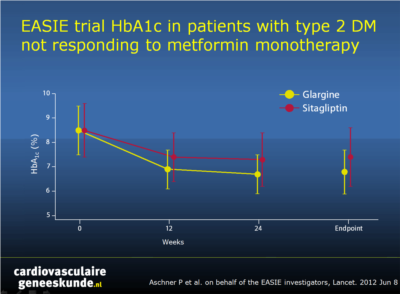Insuline glargine of sitagliptine na metformine in type 2 diabetes
Literatuur - Aschner P et al, Lancet. 2012 Jun 8. [Epub ahead of print]Insulin glargine versus sitagliptin in insulin-naive patients with type 2 diabetes mellitus uncontrolled on metformin (EASIE): a multicentre, randomised open-label trial.
Aschner P, Chan J, Owens DR, Picard et al; on behalf of the EASIE investigators.
Lancet. 2012 Jun 8. [Epub ahead of print]
Achtergrond
Het vroegtijdig bereiken van de glykemische controle met HbA1c <7% bij type 2 diabetes leidt tot voordelen op lange termijn in een verlaging van microvasculaire complicaties en kan macrovasculaire problemen verminderen [1-3]. Voor de meeste patiënten is metformine de hoeksteen van de behandeling, maar uiteindelijk hebben de meeste mensen behoefte aan aanvullende behandeling om hun glykemische doel te bereiken [4-6].In de EASIE (Evaluation of insulin glargine versus Sitagliptin in Insulin-naive patients) studie werden de werkzaamheid, veiligheid en verdraagbaarheid van basale insuline (insuline glargine) ten opzichte van een DPP-4-remmer (sitagliptine) vergeleken tijdens een 24 weken durende periode in patiënten met type 2 diabetes die niet reageerden op metformine monotherapie.
Belangrijkste resultaten
- Patiënten in de insuline glargine groep hadden een grotere gecorrigeerde gemiddelde daling van de HbA1c (n = 227; gemiddelde verandering ± standaard fout, -1,72% ± 0,06%) dan de patiënten die sitagliptine kregen (n = 253; -1,13% ± 0,06%; gemiddeld verschil, -0,5%; 95%-betrouwbaarheidsinterval [BI], -0,77 tot -0,42%; P <0,0001).
- De insuline glargine groep had een hogere geschatte snelheid van hypoglykemische episodes (4.21 ± 0.54 vs 0.50 ± 0.09 gebeurtenis per patiënt-jaar met sitagliptine, P <0,0001). Ernstige hypoglykemische bijwerkingen waren zeldzaam en kwamen voor bij 3 patiënten (1%) in de insuline glargine-groep en 1 (<1%) in de groep met sitagliptine.
Conclusie
De resultaten van deze studie ondersteunen de mogelijkheid om basale insuline te introduceren bij patiënten met type 2 diabetes die onvoldoende zijn gecontroleerd op metformine, met het potentieel voor lange termijn voordelen die voortvloeien uit het bereiken van een optimale glykemische controle vroeg in het verloop van de ziekte.
Redactioneel commentaar [7]
De studie bevestigt dat een goede dosering van basale insuline toegevoegd aan metformine effectief is in het verlagen van HbA1c. Echter, de lange termijn werkzaamheid is niet bekend.Op dit moment is het onduidelijk of start van basale insuline in het vroege stadium van diabetes type 2 zich vertaalt in langere termijn uitkomst voordelen dan wel of het vroege gebruik uiteindelijk wordt gecompenseerd door progressieve gewichtstoename en meer hypoglykemische gebeurtenissen, die beide kunnen leiden tot een verhoogd cardiovasculair risico, hogere kosten en slechte kwaliteit van leven.
Referenties
1. Holman RR, Paul SK, Bethel MA, et al. 10-year follow-up of intensive glucose control in type 2 diabetes. N Engl J Med 2008; 359: 1577–89.2. Ray KK, Seshasai SRK, Wijesuriya S, et al. Eff ect of intensive control of glucose on cardiovascular outcomes and death in patients with diabetes mellitus: a meta-analysis of randomised controlled trials. Lancet 2009; 373: 1765–72.
3. Turnbull FM, Abraira C, Anderson RJ, et al. Intensive glucose control and macrovascular outcomes in type 2 diabetes. Diabetologia 2009; 52: 2288–98.
4. IDF Clinical Guidelines Task Force. Guideline for management of postmeal glucose. Brussels: International Diabetes Federation, 2007. http://www.idf.org/webdata/docs/Guideline_PMG_fi nal.pdf (accessed Jan 10, 2012).
5. Nathan DM, Buse JB, Davidson MB, et al. Medical management of hyperglycaemia in type 2 diabetes mellitus: a consensus algorithm for the initiation and adjustment of therapy: a consensus statement from the American Diabetes Association and the European Association for the Study of Diabetes. Diabetologia 2009; 52: 17–30.
6. Rodbard HW, Blonde L, Braithwaite SS, et al. American Association of Clinical Endocrinologists medical guidelines for clinical practice for the management of diabetes mellitus. Endocr Pract 2007;13 (suppl 1): 1–68.
7. Diamant M. Choosing a blood-glucose-lowering agent after metformin. Lancet. 2012 Jun 8. [Epub ahead of print]
Abstract
BACKGROUND:In people with type 2 diabetes, a dipeptidyl peptidase-4 (DPP-4) inhibitor is one choice as second-line treatment after metformin, with basal insulin recommended as an alternative. We aimed to compare the efficacy, tolerability, and safety of insulin glargine and sitagliptin, a DPP-4 inhibitor, in patients whose disease was uncontrolled with metformin.
METHODS:
In this comparative, parallel, randomised, open-label trial, metformin-treated people aged 35-70 years with glycated haemoglobin A(1c) (HbA(1c)) of 7-11%, diagnosis of type 2 diabetes for at least 6 months, and body-mass index of 25-45 kg/m(2) were recruited from 17 countries. Participants were randomly assigned (1:1) to 24-week treatment with insulin glargine (titrated from an initial subcutaneous dose of 0•2 units per kg bodyweight to attain fasting plasma glucose of 4•0-5•5 mmol/L) or sitagliptin (oral dose of 100 mg daily). Randomisation (via a central interactive voice response system) was by random sequence generation and was stratified by centre. Patients and investigators were not masked to treatment assignment. The primary outcome was change in HbA(1c) from baseline to study end. Efficacy analysis included all randomly assigned participants who had received at least one dose of study drug and had at least one on-treatment assessment of any primary or secondary efficacy variable. This trial is registered at ClinicalTrials.gov, NCT00751114.
FINDINGS:
732 people were screened and 515 were randomly assigned to insulin glargine (n=250) or sitagliptin (n=265). At study end, adjusted mean reduction in HbA(1c) was greater for patients on insulin glargine (n=227; -1•72%, SE 0•06) than for those on sitagliptin (n=253; -1•13%, SE 0•06) with a mean difference of -0•59% (95% CI -0•77 to -0•42, p<0•0001). The estimated rate of all symptomatic hypoglycaemic episodes was greater with insulin glargine than with sitagliptin (4•21 [SE 0•54] vs 0•50 [SE 0•09] events per patient-year; p<0•0001). Severe hypoglycaemia occurred in only three (1%) patients on insulin glargine and one (<1%) on sitagliptin. 15 (6%) of patients on insulin glargine versus eight (3%) on sitagliptin had at least one serious treatment-emergent adverse event.
INTERPRETATION:
Our results support the option of addition of basal insulin in patients with type 2 diabetes inadequately controlled by metformin. Long-term benefits might be expected from the achievement of optimum glycaemic control early in the course of the disease.


Deel deze pagina met collega's en vrienden: